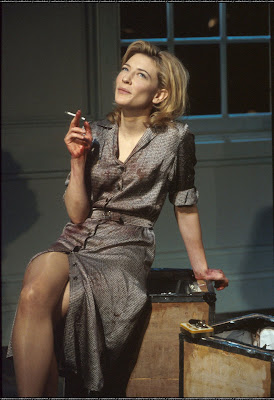Sir David Hare has said that Plenty, first mounted in 1978 under his own direction, "is about the cost of a life spent in dissent." What is being dissented from is the behavior of the British Establishment after World War II. The work spans the years 1943 to 1962 in twelve scenes. But Hare begins at the end before jumping backward in time -- in order to subordinate the what to the why and how. The central character is Susan Traherne (Cate Blanchett), who as a teenager pridefully labors in occupied France but in the peacetime that follows the war becomes increasingly disillusioned. Regrettably, it is the handling of this role that undermines the current revival, which otherwise would be superb. Hare has stated that ambiguity is indispensable so that the audience can "make its own mind up about each of the actions." To accomplish this, the leading actress should make Susan as convincing and plausible as those who oppose her. Granted that Hare has failed to provide all the motivation we would like. But the director, Jonathan Kent, has instructed (or allowed) Blanchett to go over the top into irrational tantrums far too soon. Although Susan winds up in madness, Blanchett elicits no sympathy but leaves the audience perpetually irritated and infuriated. A huge disappointment after the magnificent portrayal Kate Nelligan gave us in the original production.
The surrounding performances are excellent -- especially Julian Wadham as Susan's long-suffering husband, Raymond Brock, finally driven to explode at her, "You are selfish, brutish, unkind." Equally impressive is Richard Johnson as Sir Leonard Darwin, a government diplomat who has the decency to resign over the 1956 Suez crisis. Maria Bjornson has provided a series of stunning sets, including for some scenes an enormous (some 12 by 20 feet) painting ironically entitled "Britannia Pacificatrix."
